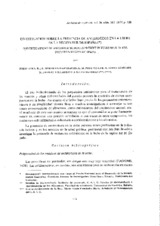Investigación sobre la presencia de antibióticos en la leche en la región sur de España
Investigations of antibiotic residues present in fluid milk in the southern region of Spain
Autor
López Giménez, R.
Pozo Lora, R.
Herrera Marteache, A.
Polo Villar, L.M.
Iglesias Pérez, J.
Jodral Villarejo, M.
Editor
Universidad de Córdoba, Servicio de PublicacionesFecha
1977Materia
LecheAntibióticos
METS:
Mostrar el registro METSPREMIS:
Mostrar el registro PREMISMetadatos
Mostrar el registro completo del ítemResumen
The presence of Penicilin, Streptomicine, Tetraciclines, Bacitracine, Neomicine and Kanamicine has been investigated in 1.346 samples of natural mil from the following provinces in the Southern region of Spain: Córdoba, Jaén, Granada, Málaga, Cádiz, Huelva and Sevilla. The microbiological tests perfomed were: a) detection of non specific inhibiting substances by the reduction of methylene blue test (Frank, 1965) and b) Jaquet and Stee"s (1952) cavities method for the detection of antibiotic substances indicated with sensitive germs. The germs used were: Sarcina Lutea (Núm. 9341 of American Collection of Culture Types, ATCC), for the Penicilin; Bacillus Subtilis (ATCC 6633), for the Streptomicine; Bacillus Cereus var. Mycoides (ATCC; 11778), for Tetraciclines; Sarcina Subflava (ATCC 7468), for the Bacitracine, and Staphilococcus Epidermis (ATCC, 12228), for the Neomicine, and Staphilococcus Aureus (ATCC, 6538-P for the Kanamicine, For each microbiological test of antibiotic detection studied, the fines of regression and the minimal detectable limits were obtained experimentally. According to the FAO/OMS mixed Comittee (1970), antibiotics should be used in such away that residues can not be detected in foods for human consumption; snd the Spanish Alimentary Code prohibits the sale and use of foods containing antibiotics. The levels of contarnination by no specific inhibiting substances is alarmingly high since it contained in 32"62 per 100 of the samples of milk analysed. Penicilin was detected in 1"19 per 100 of the samples, Streptomicine in 1.11 per 100, Tetraciclines in 1.04 per 100, Bacitracine in 9.8 per 100, Kanamicine in 0.30 per 100, and Neomicine in 1.04 per 100. Of the 1.346 milk samples analysed, 11.66 per 100 contained one or more antibiotic. In the province of Córdoba 25.87 per 100 of the milk samples contained antibiotics; in that of Jaén, 8.46 per 100; in Seville, 6.50 per 100; in Cádiz, 5 per 100; in Granada, 4 per 100, and in the province of Malaga, 2.5 per 100; no antibiotic, identificable by the methods employed, was detected in the milk of the province of Huelva. The results obtained on antibiotic contamination in the milk of the Southern region of Spain present risks to public health and posible prejudice for the milk industry. índex key words: Antibiotics in milk : Peniciline, Streptomicine, Tetracicline, Bacitracine, Neornicine, Kanamicine in milk; Contaminantes in milk. Se ha investigado la presencia de penicilina, estreptomicina, tetraciclinas, ba¬citracina, neomicina y kanamicina en 1346 muestras, de leche natural, procedentes de diferentes zonas de las siguientes provincias de la región sur de España: Córdoba, Jaén, Granada, Málaga, Cádiz, Huelva y Sevilla. Las pruebas microbiológicas han sido: a) detección de sustancias inhibidoras inespecíficas por la prueba de reducción del azul de metileno (Frank, 1965) y b) método de las cavidades de Jacquet y Steeg (1952) para la detección de las surtan cias antibióticas indicadas con gérmenes sensiblesios gérmenes sensibles utilizados han sido: para la la penicilina, la Sarcina lutea (núm. 9341 de la Colección Americana de cultivos tipo, ATCC); para la estreptomicina, el Bacillus subtilis (ATCC 6633); para las tetraciclinas, el Bacillus cereus var mycoides (ATCC 11778); para la bacitracina, la Sarcina subflava (ATCC 7468); para la neomicina, el Staphilococcus epidermis (ATCC 12228); y para la kanamicina, el Staphylococcus aureus (ATCC 6538-P). Se han obtenido experimentalmente, para cada prueba microbiológica de detección específica de los antibióticos estudiados, las líneas de regresión y los límites mínimos detectables. Según el Comité mixto FAO/OMS (1970) los antibióticos deben emplearse de forma que no se detecten residuos en los alimentos para consumo humano; y el Código alimentario español prohíbe la venta y utilización de alimentos con antibióticos. El nivel de contaminación por sustancias inhibidoras inespecíficas es alarmantemente alto ya que el 32"62 p. 100 de las muestras de leche analizadas lo contenían. La penicilina se ha detectado en el 1"19 p. 100 de las muestras, la estreptomicina en el 1"11 p. 100, las tetraciclinas en el 1"04 p. 100, la bacitracina en el 9"8 p. 100, la kanamicina en el 0"30 p. 100 y la neomicina en el 1"04 p. 100. De las 1346 muestras de leche analizadas, el 11"66 p. 100 contenían uño o más antibióticos. En la provincia de Córdoba el 25"87 p. 100 dulas muestras de leche presentaron antibióticos; en leche de la provincia de Jaén, el 8"46 p. 100; en la provincia de Sevilla, el 6"50 p. 100; en Cádiz, el 5 p. 100; en Granada, el 4 p. 100; y en la provincia de Málaga, el 2"5 p. 100. No se ha encontrado ningún antibiótico identificable por los métodos empleados en la provincia de Huelva. Los resultados obtenidos sobre contaminación por antibióticos de la leche de la región sur de España presentan riesgos para la salud pública y posible perjuicio para la industria lechera fermentadora. Palabras clave genéricas: Antibióticos en leche; penicilina, estreptomicina, tetraciclinas, bacitracina, neomicina, kanamicina en leche; contaminantes en leche.

